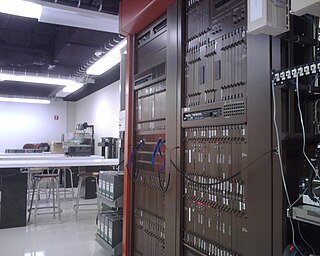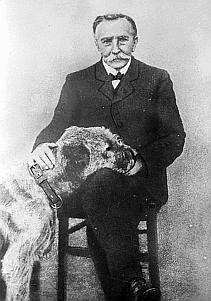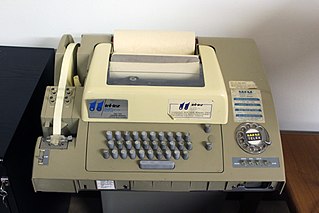
A voicemail system is a computer-based system that allows users and subscribers to exchange personal voice messages; to select and deliver voice information; and to process transactions relating to individuals, organizations, products, and services, using an ordinary phone. The term is also used more broadly to denote any system of conveying a stored telecommunications voice messages, including using an answering machine. Most cell phone services offer voicemail as a basic feature; many corporate private branch exchanges include versatile internal voice-messaging services, and *98 vertical service code subscription is available to most individual and small business landline subscribers.

Digital Multiplex System (DMS) is the name shared among several different telephony product lines from Nortel Networks for wireline and wireless operators. Among them are the DMS-1 Rural/Urban digital loop carrier, DMS-10 telephone switch, the DMS SuperNode family of telephone switches, and the S/DMS optical transmission system.
The public switched telephone network (PSTN) provides infrastructure and services for public telecommunication. The PSTN is the aggregate of the world's circuit-switched telephone networks that are operated by national, regional, or local telephony operators. These consist of telephone lines, fiber optic cables, microwave transmission links, cellular networks, communications satellites, and undersea telephone cables, all interconnected by switching centers which allow most telephones to communicate with each other.

This timeline of the telephone covers landline, radio, and cellular telephony technologies and provides many important dates in the history of the telephone.

A business telephone system is a multiline telephone system typically used in business environments, encompassing systems ranging in technology from the key telephone system (KTS) to the private branch exchange (PBX).

The DMS-100 is a member of the Digital Multiplex System (DMS) product line of telephone exchange switches manufactured by Northern Telecom. Designed during the 1970s and released in 1979, it can control 100,000 telephone lines.
A class-5 telephone switch is a telephone switch or telephone exchange in the public switched telephone network located at the local telephone company's central office, directly serving subscribers. Class-5 switch services include basic dial-tone, calling features, and additional digital and data services to subscribers connected to a local loop.
Local telephone service is the provision of telecommunications networks and services within a limited geographic region.
Stromberg-Carlson was a telecommunications equipment and electronics manufacturing company in the United States. It was formed in 1894 as a partnership by Swedish immigrants Alfred Stromberg and Androv Carlson. It was one of five companies that controlled the national supply of telephone equipment until after World War II.
Siemens Communications was the communications and information business arm of German industrial conglomerate Siemens AG, until 2006. It was the largest division of Siemens, and had two business units – Mobile Networks and Fixed Networks; and Enterprise.
The Elektronisches Wählsystem Digital (EWSD), translated to Electronic Digital Switching System in English, is a widely installed German telephone exchange system, originally introduced in 1975 by Siemens AG, but discontinued in 2017.
ROLM Corporation was a technology company founded in Silicon Valley in 1969.IBM Corp. partnered with the company, and ROLM Mil-Spec was sold to Loral Corporation and later to Lockheed Martin in 1996 as Tactical Defense Systems. IBM's ROLM division was later half sold to Siemens AG in 1989, whereupon the manufacturing and development became wholly owned by Siemens and called ROLM Systems, while marketing and service became a joint venture of IBM with Siemens, called ROLM Company. After nearly 30 years, phone products with the name "Rolm" were discontinued in the late 1990s, as sales dropped in markets dominated by new technology with other products or other companies.
Stored program control (SPC) is a telecommunications technology used for telephone exchanges controlled by a computer program stored in the memory of the switching system. SPC was the enabling technology of electronic switching systems (ESS) developed in the Bell System in the 1950s, and may be considered the third generation of switching technology. Stored program control was invented by Bell Labs scientist Erna Schneider Hoover in 1954 who reasoned that computer software could control the connection of telephone calls.
The IBM 1750, 2750 and 3750 Switching Systems were telephone exchange systems produced by IBM from the 1960s to the 1990s.

A PSTN network topology is the switching network topology of a telephone network connected to the public switched telephone network (PSTN).

A telephone exchange, telephone switch, or central office is a telecommunications system used in the public switched telephone network (PSTN) or in large enterprises. It interconnects telephone subscriber lines or virtual circuits of digital systems to establish telephone calls between subscribers.

The telex network was a customer-to-customer switched network of teleprinters similar to a telephone network, using telegraph-grade connecting circuits for two-way text-based messages. Telex was a major method of sending written messages electronically between businesses in the post-World War II period. Its usage went into decline as the fax machine grew in popularity in the 1980s.
Genband US LLC was a privately held company that makes IP-based real time communications software products for fixed wireline, mobile, and cable service providers as well as large enterprises. The company was formed in 1999 as General Bandwidth, and is headquartered in Frisco, Texas. In the following 15 years it acquired several other companies doing related work.
Ribbon Communications US LLC is a public company that makes IP-based real-time communication security and software products and services for fixed wireline, mobile, and cable service providers as well as large enterprises. The company was formed in 2017, following the merger of Genband and Sonus Networks and is headquartered in Westford, Massachusetts.






